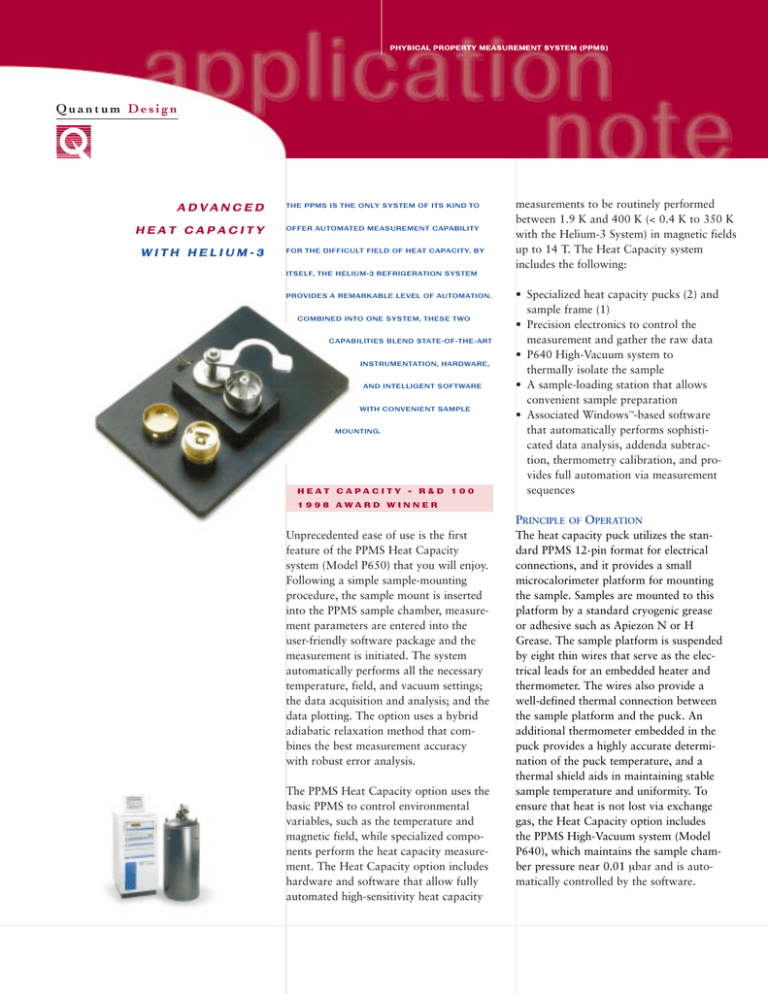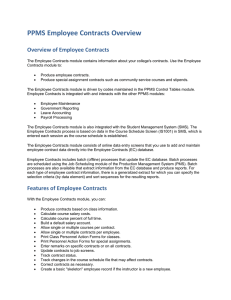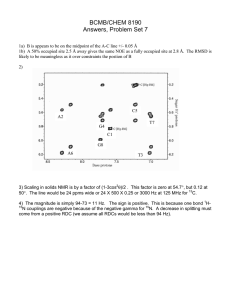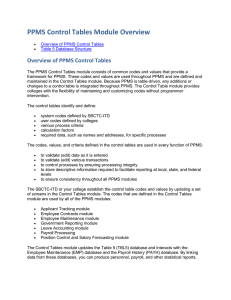measurements to be routinely performed
advertisement

PHYSICAL PROPERTY MEASUREMENT SYSTEM (PPMS) Quantum Design ADVANCED THE PPMS IS THE ONLY SYSTEM OF ITS KIND TO HEAT CAPACITY OFFER AUTOMATED MEASUREMENT CAPABILITY WITH HELIUM-3 FOR THE DIFFICULT FIELD OF HEAT CAPACITY. BY measurements to be routinely performed between 1.9 K and 400 K (< 0.4 K to 350 K with the Helium-3 System) in magnetic fields up to 14 T. The Heat Capacity system includes the following: ITSELF, THE HELIUM-3 REFRIGERATION SYSTEM PROVIDES A REMARKABLE LEVEL OF AUTOMATION. COMBINED INTO ONE SYSTEM, THESE TWO CAPABILITIES BLEND STATE-OF-THE-ART INSTRUMENTATION, HARDWARE, AND INTELLIGENT SOFTWARE WITH CONVENIENT SAMPLE MOUNTING. HEAT CAPACITY – R&D 100 • Specialized heat capacity pucks (2) and sample frame (1) • Precision electronics to control the measurement and gather the raw data • P640 High-Vacuum system to thermally isolate the sample • A sample-loading station that allows convenient sample preparation • Associated Windows™-based software that automatically performs sophisticated data analysis, addenda subtraction, thermometry calibration, and provides full automation via measurement sequences 1998 AWARD WINNER PRINCIPLE Unprecedented ease of use is the first feature of the PPMS Heat Capacity system (Model P650) that you will enjoy. Following a simple sample-mounting procedure, the sample mount is inserted into the PPMS sample chamber, measurement parameters are entered into the user-friendly software package and the measurement is initiated. The system automatically performs all the necessary temperature, field, and vacuum settings; the data acquisition and analysis; and the data plotting. The option uses a hybrid adiabatic relaxation method that combines the best measurement accuracy with robust error analysis. The PPMS Heat Capacity option uses the basic PPMS to control environmental variables, such as the temperature and magnetic field, while specialized components perform the heat capacity measurement. The Heat Capacity option includes hardware and software that allow fully automated high-sensitivity heat capacity OF OPERATION The heat capacity puck utilizes the standard PPMS 12-pin format for electrical connections, and it provides a small microcalorimeter platform for mounting the sample. Samples are mounted to this platform by a standard cryogenic grease or adhesive such as Apiezon N or H Grease. The sample platform is suspended by eight thin wires that serve as the electrical leads for an embedded heater and thermometer. The wires also provide a well-defined thermal connection between the sample platform and the puck. An additional thermometer embedded in the puck provides a highly accurate determination of the puck temperature, and a thermal shield aids in maintaining stable sample temperature and uniformity. To ensure that heat is not lost via exchange gas, the Heat Capacity option includes the PPMS High-Vacuum system (Model P640), which maintains the sample chamber pressure near 0.01 mbar and is automatically controlled by the software. PPMS ADVANCED HEAT CAPACITY WITH HELIUM-3 APPLICATION NOTE ➤ Heat Capacity dialog box prompts you to input required measurement parameters ➤ Heat Capacity measurement status viewer The heat capacity mounting station helps protect the sample platform and its suspending leads when mounting and removing a sample. A built-in vacuum line securely holds the platform in place so that samples may be mounted or removed without generating stress on the supporting wires. A single heat capacity measurement consists of several distinct stages. First, the sample platform and puck temperatures are stabilized at some initial temperature. Power is then applied to the sample platform heater for a predetermined length of time, causing the sample platform temperature to rise. When the power is terminated, the temperature of the sample platform relaxes toward the puck temperature. The sample platform temperature is monitored throughout both heating and cooling, providing (with the heater power data) the raw data of the heat capacity calculation. Two separate algorithms fully automate the analysis of the raw data. The most general analysis method invokes the twotau model ™* which assumes that the sample is not in good thermal contact with the sample platform. The values of the heat capacity and other physical parameters are determined by optimizing the agreement between the measured data and the two-tau model. In the two-tau model, the first time-constant (tau 1) represents the relaxation time between the sample platform and the puck, and the second time constant (tau 2) represents the relaxation time between the sample platform and the sample itself. A second analysis is also performed using a simpler model that assumes perfect thermal coupling between the sample and the sample platform. The heat capacity software determines which model best fits the measured data and automatically saves the values of the sample heat capacity, addenda heat capacity, thermal coupling between the sample and the platform, thermal time-constants, and other information to the data file. ADDITIONAL FEATURES • Advanced heat capacity algorithms calculate the actual thermal coupling of the sample to the microcalorimeter platform, curve fit the data, and then compensate for this coupling when determining the heat capacity of the sample. • A built-in data subtraction feature automatically corrects for the background heat capacity of the sample platform and adhesive. • All calculated fitting parameters and raw data, including a c2 quality value, are saved in the data file. • The duration of a measurement is specified in terms of thermal time-constants rather than seconds. This implementation makes efficient use of the measurement time, because thermal time-constants may range from 100 ms at low temperatures to over 100 s at elevated temperatures. • The PPMS verifies the electrical lead continuity and thermometry accuracy when the puck is installed. This verifies that the correct thermometer calibration file is used and that any unexpected electronic shorts or open circuits are detected before starting the measurement. • Several heat capacity measurements may be automatically averaged. • The units of a heat capacity measurement can be expressed as one of a variety of units, including specific heat. • Debye temperature can be automatically calculated and written to the data file at every measurement point. * A detailed explanation of the two-tau model is described as the “curve fitting” in “Measurement of Heat Capacity By Fitting the Whole Temperature Response of a Heat-Pulse Calorimeter” by Jih Shang Hwang, Kai Lin, and Cheng Tien, Rev. Sci. Instrum. Vol. 68 (1), January 1997, p. 94. The PPMS heat capacity option optimizes both the measurement accuracy and efficiency you have come to expect from Quantum Design products. Sophisticated analysis routines and integrated addenda subtraction automatically compensate for common experimental artifacts. SPECIFICATIONS (WITH ZERO FIELD) Temperature Range: 1.9–400 K Sample Size: 1–500 mg (20 mg, typ.) Heat Capacity Resolution: 10 nJ/K @ 2 K Measurement Accuracy: < 5%, 2–300 K < 2%, typ. HELIUM-3 SYSTEM Model P825, the Helium-3 System, expands the temperature range of the PPMS below the standard 1.9 K temperature limit. This fully automated, closed-cycle 3He probe installs easily into the sample space of the PPMS to extend the minimum experimental temperature to below 0.4 K. This option is compatible with the Heat Capacity, Resistivity, and AC Transport measurement capabilities. To simplify operation, the system comes from the factory pre-charged ➤ Helium-3 probe with 3He without the need for any assembly or connection of any pumping lines. Incorporating all of its components into a cart, the Helium-3 System can be rolled out of the way for safe storage when not in use. Only electrical cable connections are required to make the system active. This revolutionary system design has eliminated the need to manually operate any valves. The accompanying software provides fully automated control of the pumping system and temperature. need to remove the probe or manually turn any valves to sweep temperature from 0.4 to 350 K. DESIGN FEATURES PRINCIPLE One of the benefits of the Quantum Design Helium-3 System is that it is a continuously circulating system. Unlike traditional “one-shot” designs, this system implements a return line that allows 3 He to continuously flow back into the reservoir. Therefore, regeneration time is not required to maintain uninterrupted operation at low temperatures. However, for measurements that require temperatures below 0.5 K, the system can enter a one-shot mode by automatically activating a shut-off valve in the return line. Additionally, by utilizing the vacuumsealed sample chamber of the PPMS, no low temperature seals are required to use the 3He probe. Consequently, leak testing is not necessary after mounting your sample, saving valuable hours each time a sample is introduced to the system. The base of the 3He-refrigerator probe plugs into the 12-pin connector, which provides electrical access to the measurement hardware at the bottom of the PPMS sample chamber. Thermal anchoring baffles along the probe assist in cooling and maintaining the probe at a base temperature of 1.9 K. Two gas-handling lines run through the length of the probe: the pump line and the return line. 3He gas flows down the return line and condenses into the reservoir in the base of the probe. A turbo pump mounted at the top of the insert pumps on the liquid 3He via the pump line, thus reducing the temperature. This reservoir is thermally linked to the sample stage that houses a thermometer, heater, and the interface for the samplemounting platforms. Samples are mounted on measurement-specific sample mounts that plug into the sample stage. Most importantly, the PPMS Helium-3 System provides unprecedented ease of use. Working seamlessly with the PPMS, heat capacity and transport property systems, measurements may be performed without a need for the user to build additional hardware. The PPMS MultiVu software provides sequencing capabilities for automating all measurements. The software, without further input from the user, controls all pumps and system mechanisms. For example, to send the system to 0.5 K, you need to only insert the probe and enter the target temperature. Furthermore, with the Helium-3 System installed, your measurements are not limited to lower temperatures. Without any user intervention, other then setting a sequence to higher temperatures, the system will perform measurements up to 350 K. You do not OF OPERATION ➤ Complete Helium-3 System with probe, diaphragm pump, and cart Temperature control is achieved by a combination of varying the speed of a specially designed turbo pump system and using a sample stage heater. Varying the speed of the turbo pump accommodates changes in the 3He vapor pressure in the pumping lines and allows for different cooling powers. The sample stage heater rapidly ramps the temperature from the lowest temperature to 4 K, while the standard PPMS temperature control is invoked above 4 K. After a sample is mounted to the sample stage and the refrigerator is subsequently inserted into the sample chamber, the PPMS cools the sample chamber to 1.9 K. Once the sample chamber is cold, the 3He refrigerator is automatically activated and begins to condense 3He. Since 3He is constantly recycling, there is no limitation on how long the refrigerator will stay cold. This, however, does require the PPMS temperature control to hold the sample chamber at 1.9 K continuously, which requires the P800 Continuous Low-Temperature Control (CLTC) option. SAMPLE MOUNTING SPECIFICATIONS: Sample mounting has been simplified by the use of plug-in sample mounts. Samples are mounted on these easy-tohandle platforms which plug into the stage that is connected to the cold finger of the refrigerator. This mounting stage can be rotated manually up to 140˚ about the longitudinal axis of the sample space. Sample mounts may be swapped in a matter of minutes, minimizing the time required to change samples. The Helium3 System ships with two heat capacity and three resistivity sample platforms. Minimum Temperature: Continuous mode < 0.5 K One-shot < 0.4 K Measurement Temperature Range when Helium-3 Installed: < 0.4 K–350 K Cooling Down Time: 300 to < 0.5 K in under 3 hours (2 hours typ.) PPMS SYSTEM REQUIREMENTS Quantum Design’s expertise is blending a reliable and robust system design with components that allow a high degree of experimental access and functionality. Our trademark has always been to provide users with systems that maximize performance and automation. • P400 Resistivity option • P800 Continuous Low-Temperature Control (CLTC) • P640 High-Vacuum System (an integral component of the P650 Heat Capacity Measurement System) ➤ Heat capacity and resistivity sample mounts for the Helium-3 System Quantum Design WORLD HEADQUARTERS 6325 Lusk Boulevard, San Diego, California, USA 92121-3733 800-289-6996 • 858-481-4400 • fax 858-481-7410 email: info@qdusa.com • http://www.qdusa.com Rev 8.04


